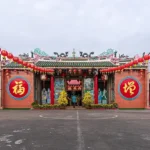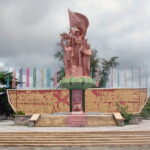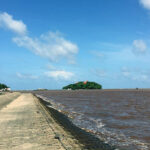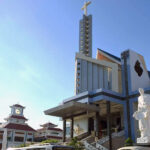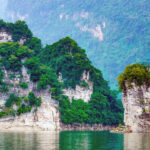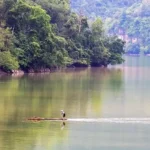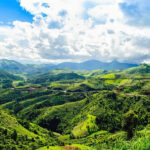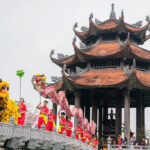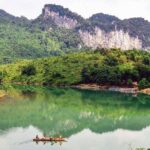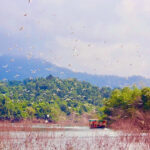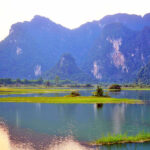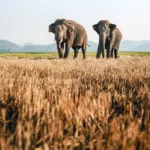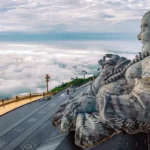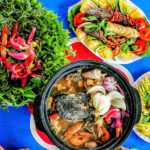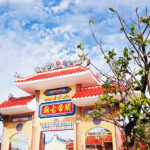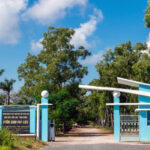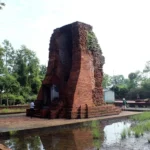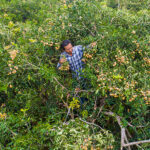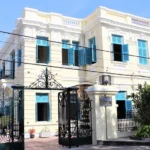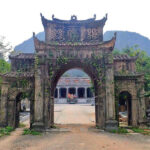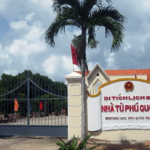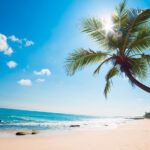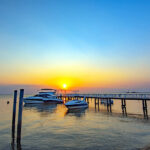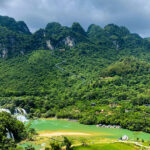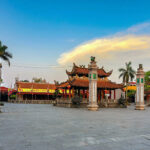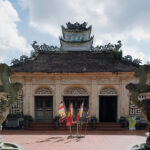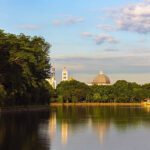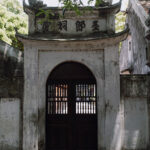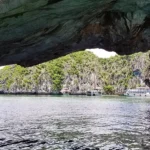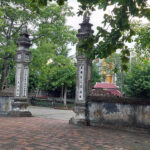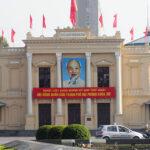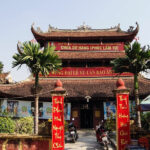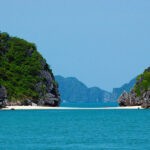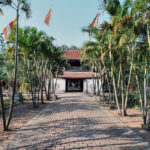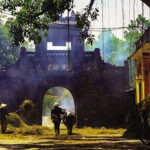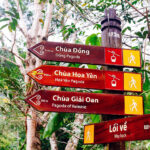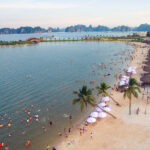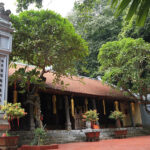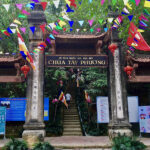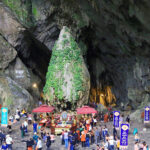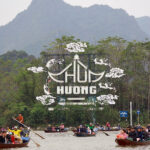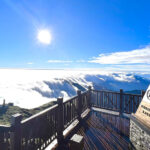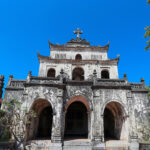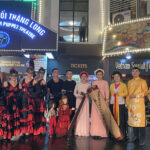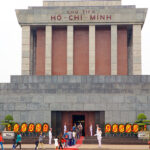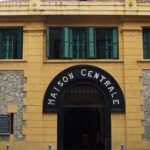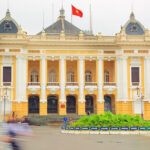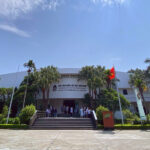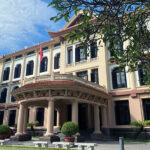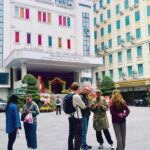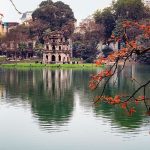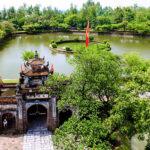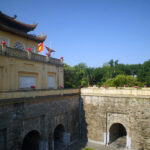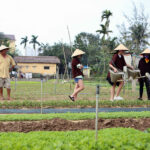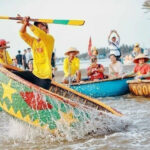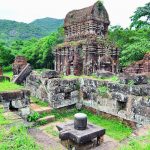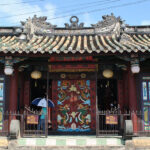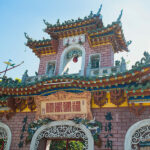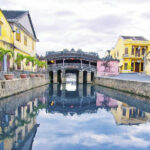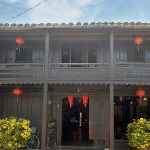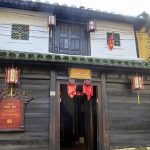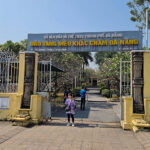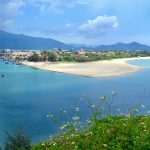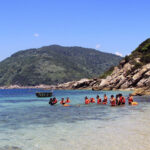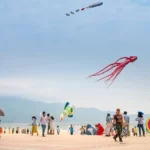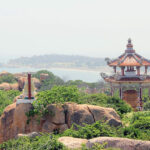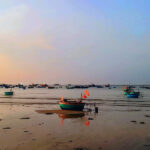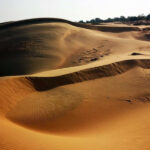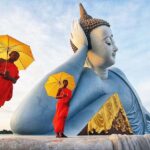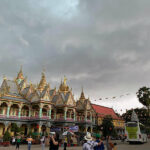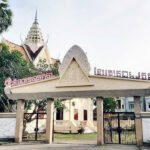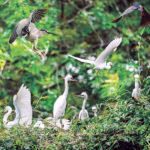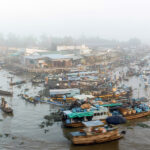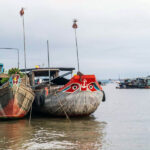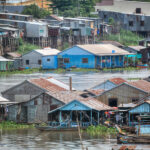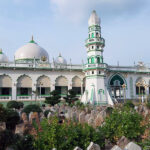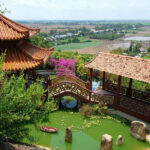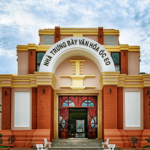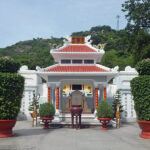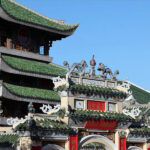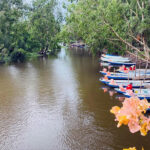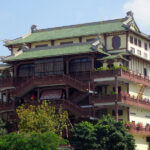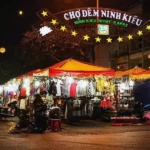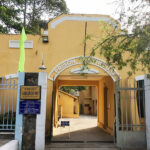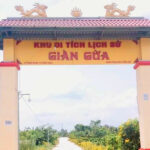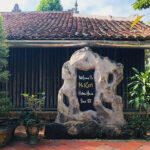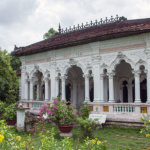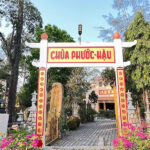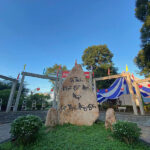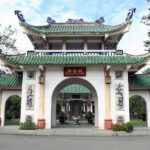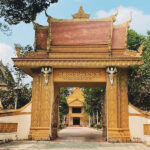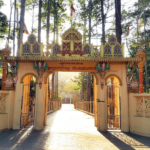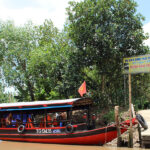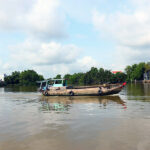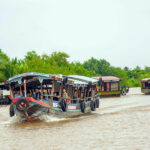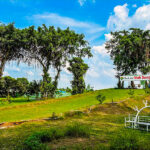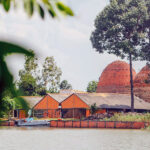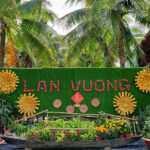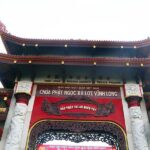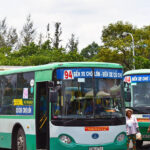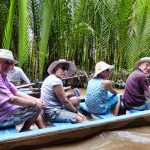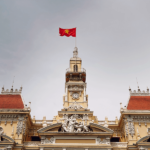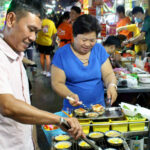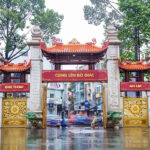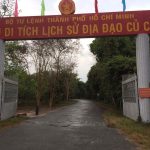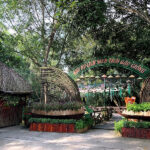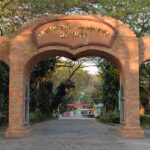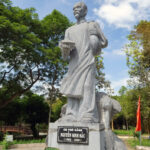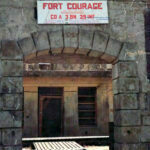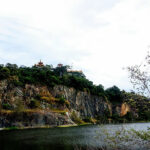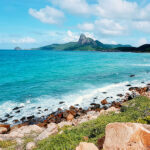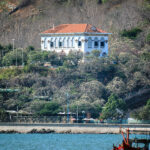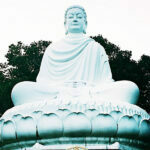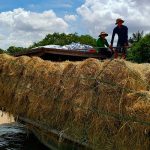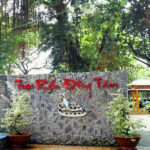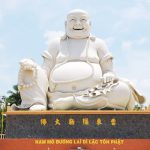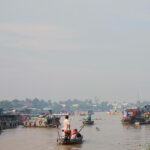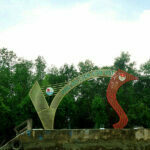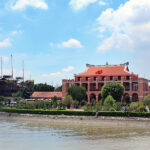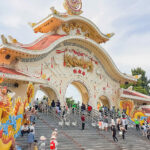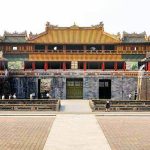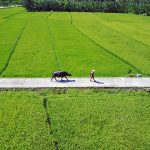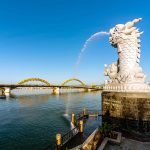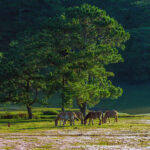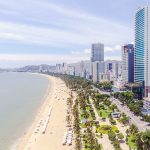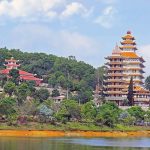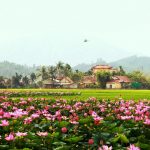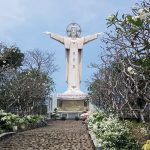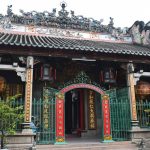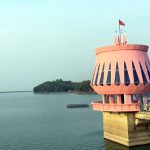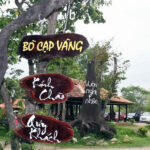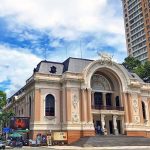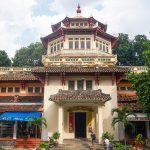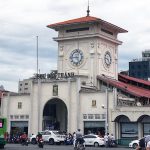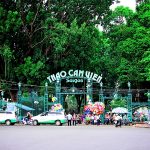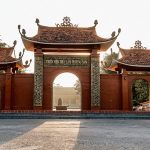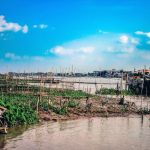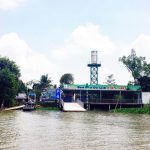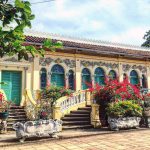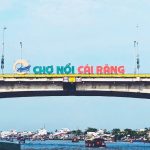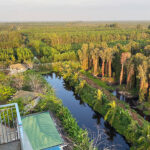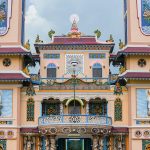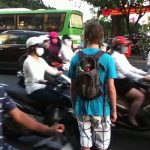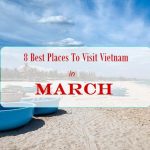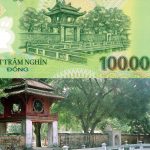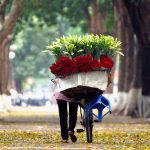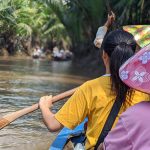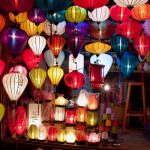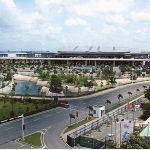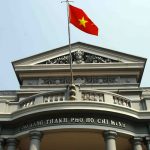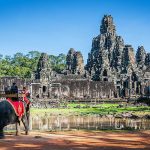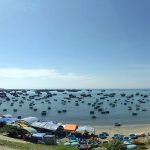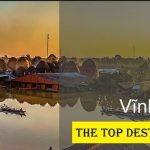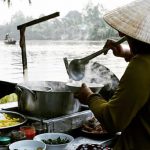Phu Tho is adjacent to Hanoi and is the gateway to the Northwest region. This place impresses tourists with its diverse landscapes from rivers, lakes, mineral springs, national parks and historical – cultural relics, intangible cultural heritages on the UNESCO list… In recent years, Phu Tho has further affirmed its attraction when a series of resorts were established, in line with the current trend of relaxation and health care.
Table of Contents
General information about Phu Tho
Phu Tho is a province in the Northeast region of Vietnam. Phu Tho is considered the ancestral land of the Vietnamese people. Legend has it that here, the Hung Kings founded the country of Van Lang – the first state of Vietnam, with the capital being Phong Chau, the area around Viet Tri ward today. Phu Tho province has the following geographical location:
- Bordering the capital Hanoi and Ninh Binh province to the East
- Bordering Lao Cai province and Son La province to the West
- Bordering Thanh Hoa province to the South
- Bordering Thai Nguyen province and Tuyen Quang province to the North.
In 2025, Hoa Binh and Vinh Phuc provinces was merged into Phu Tho province, with a total area of 9,361 km².
What’s the best time to visit Phu Tho?
As a province located in the midland and mountainous region of the North, the weather has four distinct seasons: spring, summer, autumn and winter.
+ Spring is the season for spiritual tourism and every year in the third lunar month, hundreds of thousands of tourists come here to make a pilgrimage to the Hung Temple Historical Site.
+ The summer climate is usually high, with a lot of rain between July and August. The cold and dry winter usually lasts from October to March. Usually, tourists in Hanoi like to come to Hoa Binh in the summer to avoid the heat, because the weather in Hoa Binh is cool at this time.
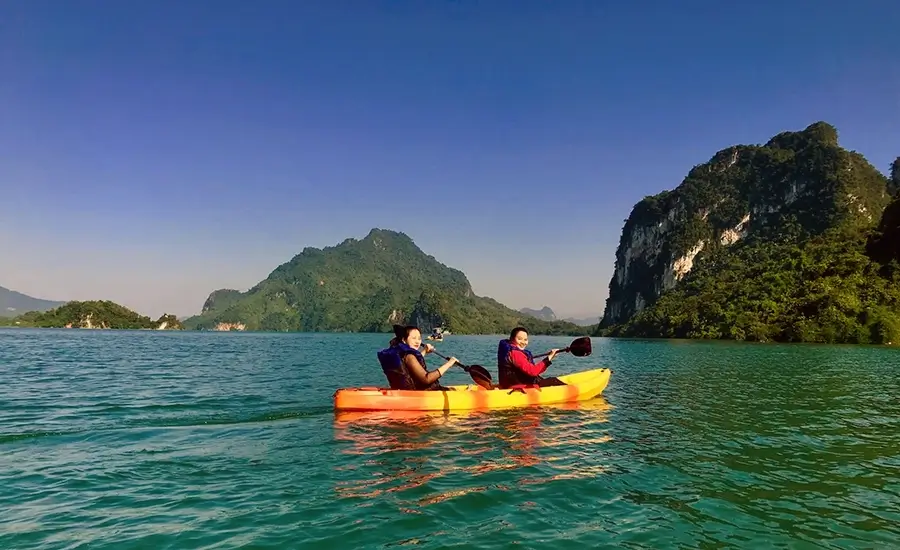
kayaking in Hoa Binh lake.
+ From May to June, Phu Tho tourism will attract tourists because of the golden rice season in Mai Chau. June to August is the season when the Da River water in Thung Nai is clear blue… Visitors should not forget to visit Kim Boi hot spring in winter or Lung Van in spring when hundreds of flowers bloom, the mist covers the Muong houses halfway up the mountain.
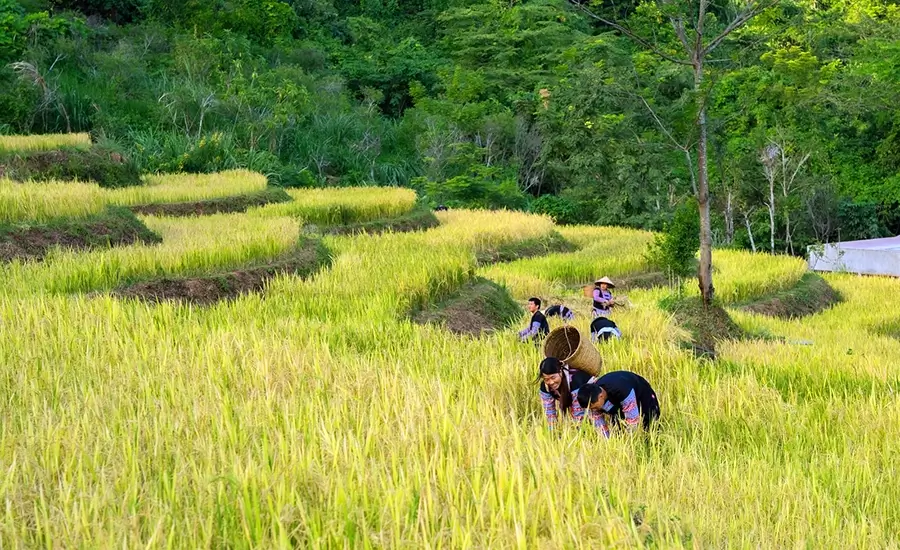
In general, the climate of this land is quite pleasant, so you can travel to Hoa Binh all year round. Each season will bring you unexpected experiences, creating excitement for each journey of discovery.
How to get there?
To travel to Hoa Binh, you have many options of means of transport to suit your needs:
– Tourist bus: From Hanoi, there are many buses departing from My Dinh or Yen Nghia bus stations, with a travel time of about 1.5-2 hours. This is a popular means of transport, with fares ranging from 80,000 to 150,000 VND depending on the vehicle type. Limousines offer more privacy and comfort, with fares starting from 220,000 VND one way. Some suggested bus companies are Mang Kien, Xuan Trang, Anh Dung, with drop-off points at resorts in Mai Chau.
– Motorbike: If you love to experience and explore, riding a motorbike is a great choice. From Hanoi, you can follow National Highway 6, a route of about 80 km with beautiful scenery along the way. This route is quite easy to travel, suitable for those who want to combine backpacking and tourism.
– Private car to Phu Tho: This option is suitable for families or groups of friends. From Hanoi, travel along the Hoa Lac – Hoa Binh highway, taking about 1.5 hours. You can stop at tourist attractions along the way as you like.
Currently, Phu Tho does not have a civil airport, tourists from further away fly to Hanoi and then take another transportation to Hoa Binh.
Accommodation in Phu Tho
Tourist attractions in Phu Tho are relatively far from each other, so hotels and homestays are also built concentrated near the destinations. The 4-5 star hotels are usually most in the center of Viet Tri ward such as Muong Thanh Luxury Phu Tho, Garden Viet Tri… Room rates here start from 800,000 VND per night. Some resorts in Thanh Thuy hot spring area: Thanh Thuy Helth Resort, Thanh Lam Resort. Xuan Son National Park has Xuan Son Homestay, Lam homestay… concentrated in Du village, bearing the architecture and culture of the Dao ethnic group. Here, visitors can breathe fresh air, experience the rustic lifestyle with the locals and especially enjoy the specialties.

A view of Mai Chau Hideaway (photo source: collected).
Visitors to Vinh Phuc often book rooms in Tam Dao or around Dai Lai Lake to enjoy their vacation. Tam Dao has many homestays, motels, and hotels from budget to luxury. Room rates vary from 450,000 VND to 2,000,000 VND per night. Some beautiful homestays, conveniently located with reasonable prices for young people are 90s Homestay, Cuden, Levent, Le Bleu… Choosing a more upscale resort or hotel, you can think of Tam Dao Belvedere, May Villa…Some 5-star hotels are Flamingo Dai Lai Resort, Westlake Hotel & Resort, FLC Vinh Thinh, DIC STAR Vinh Phuc. Flamingo Dai Lai Resort is popular with tourists thanks to its private space amidst pine forests, lakes, entertainment complexes, spas, golf courses, restaurants… and a system of luxury villas. Rental prices range from about 2,000,000 to 13,000,000 per night.
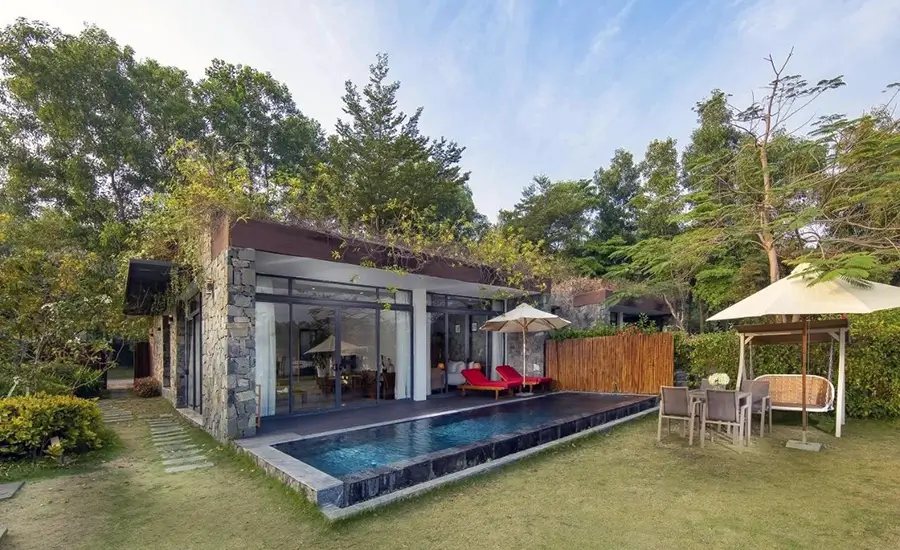
Flamingo Dai Lai in Vinh Phuc (photo source: collected).
In the Mai Chau area, there are many beautiful places to stay, typically the isolated resort Avana Retreat, Mai Chau Ecolodge, Bakhan Village Resort… The price of staying here is from 1.5 – 3 million VND per night on weekdays. The Kim Boi area is famous for its hot springs, so the resorts here are suitable for all four seasons. Serena Resort Kim Boi is located in Khai Doi hamlet, Sao Bay commune, inspired by the beauty and culture of the Northwest and built from stone, wood, bamboo, thatched roofs… close to nature. There is a Japanese-style Onsen bath area, or indoor hot baths… The price of staying here is from 1.8 million VND per night. Visitors can refer to VResort in Kim Boi.

A view of Mai Chau Ecolodge (photo source: collected)
In the Luong Son area, Doi Co Thom resort in Ram hamlet, Cu Yen commune is a suggestion for visitors. There are modern, luxurious villas located on green grassy hills. Amenities include many outdoor swimming pools, jacuzzis, and Dao herbal bath services. Satoyama Village in Cu Yen commune just opened earlier this year. The resort is built in Vietnamese-Japanese style, with a sauna, Japanese-style Onsen mineral baths, etc. The price for a night’s stay here starts at VND2,000,000.
Tourist attractions in Phu Tho
Nature and wildlife areas
Tam Dao and national park
 Tam Dao is an ideal summer resorts in the North, located 900m above sea-level, approximately 86km from Hanoi. Tam Dao mountains are 80km long, 10-15km wide. At the early the 20th century (1904-1906), it was transformed into a resort with the comprises villas, hotels, restaurants, sport fields, swimming pools and dancing halls by the French.
Tam Dao is an ideal summer resorts in the North, located 900m above sea-level, approximately 86km from Hanoi. Tam Dao mountains are 80km long, 10-15km wide. At the early the 20th century (1904-1906), it was transformed into a resort with the comprises villas, hotels, restaurants, sport fields, swimming pools and dancing halls by the French.
Tam Dao range has three peaks: Ban Thach with 1.388m high. Thien Nhi with 1,375m high and Phu Nghia with 1.400m high which emerge like three islets. The weather is cool all year round with an average temperature of 20 – 22ºC and it may changes four seasons in a day. During the hottest days, the temperature reaches 27ºC. Long ago, Tam Dao was a tourist attraction.
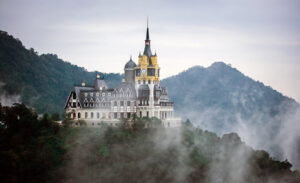
Nowadays, Tam Dao becomes tourist resort with an area of 235 ha lying at the attitude of 900m above sea level. It is a wonderful resort with fresh, pure and cooling air, beautiful scenery. Many hotels, guesthouses and restaurants are ready to serve tourists. It is worth to visit when tourists take a walk on zigzaging mountain path to sightsee the landscape of mountain and forest in this place. Other few places that should be listed in tourists intinerary are Bac Waterfall, Mother Goddess Temple, Phu Nghia Peak. Tam Dao is a tourist attraction frequented by thousands of visitors in summer.
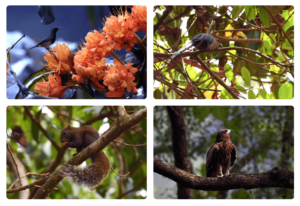 The Tam Dao national park can be reached if you follow National Road No2 to Vinh Yen town where you should turn right into National Road 2B and go head about 13km. The centre of this natural park is located in Tam Dao commune, 70km north-west of Hanoi.
The Tam Dao national park can be reached if you follow National Road No2 to Vinh Yen town where you should turn right into National Road 2B and go head about 13km. The centre of this natural park is located in Tam Dao commune, 70km north-west of Hanoi.
Located on the Tam Dao mountain range, the park covers an area of 36,883 ha. Tam Dao is in a vast high mountainous region affected by tropical humid monsoons. The average temperature during the years is 23ºC. The mean humidity is about 84%. The vegetation cover is prepresentative of five types of tripical forest. The flora consists of 904 species classifies into 478 genera and 213 families of high plants, 64 of which are listed in Vietnam’s Red Book. The rich fauna includes 307 species, 56 of which are registered in Vietnam’s Red Book (22 mammal species, 17 reptile species, 9 bird species, 7 amphibian species and the remainder of insects).
Dai Lai Lake
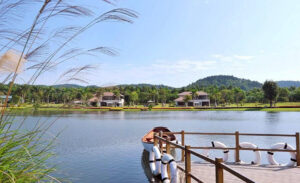 Dai Lai Lake is located in Ngoc Thanh and Cao Minh Commune, more than 40 km from Hanoi, right at the foot of Tam Dao Mountain. As an artificial lake, Dai Lai is like a precious gem created by humans. Amidst the rolling hills and forests is a vast blue lake, reflecting the mountains, clouds and sky all year round.
Dai Lai Lake is located in Ngoc Thanh and Cao Minh Commune, more than 40 km from Hanoi, right at the foot of Tam Dao Mountain. As an artificial lake, Dai Lai is like a precious gem created by humans. Amidst the rolling hills and forests is a vast blue lake, reflecting the mountains, clouds and sky all year round.
The lake covers 525 hectares. Over the lake lies a 3 hectare-island, and the highest point of island is more than 23m which is home to different kinds of birds. To the west and southwest of the lake stands Than Lan mountain. Atop the mountain, one can get a panoramic view of the lake. Many enchanting artificial beaches line along the clear and blue water, under the foot of different hills. Coming here, visitors can stroll, sightsee, go on a cruise, swim in the lake, fish, climb mountains… or enjoy special ethnic dishes.
Xuan Son National Park
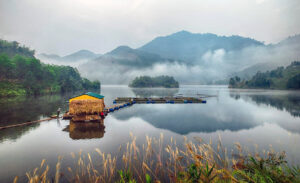 Xuan Son National Park in Xuan Dai commune is an attractive tourist destination of Phu Tho every summer. A day at Xuan Son National Park will have all four seasons: cool mornings like spring, noon like summer, cool afternoons like autumn and cold evenings like winter. This is a suitable destination for guests who like eco-tourism and resort tourism. The ethnic communities here still maintain the typical cultural beauty of their ethnic groups, so visitors can learn about the cultural life and exchange arts with the Dao and Muong ethnic groups.
Xuan Son National Park in Xuan Dai commune is an attractive tourist destination of Phu Tho every summer. A day at Xuan Son National Park will have all four seasons: cool mornings like spring, noon like summer, cool afternoons like autumn and cold evenings like winter. This is a suitable destination for guests who like eco-tourism and resort tourism. The ethnic communities here still maintain the typical cultural beauty of their ethnic groups, so visitors can learn about the cultural life and exchange arts with the Dao and Muong ethnic groups.
Cover 15,46 hectares, this national park boast cool weather all year round, a diversified flora and fauna. There has strange species of plant whose leaves can change colour four times a day. Of the 32 floral species many are to be preserved and have high economic value, including textured wood (chkrasia), thitka and so on. The fauna has 46 species listed in the Red Book of Endangered Animals in Vietnam and 18 listed in the world Red Book.
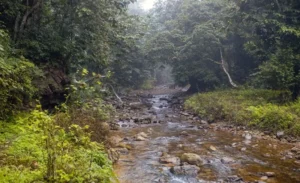 The mountains, caves and forests create magnificent landscape. There have three mountains inside the resort, namely Voi mountain (1,387m above sea level), Ten mountain (1,244 m) and Can Mountain (1,144 m). Bats take shelter in the caves here. The stalactiles and stalagmites inside the caves have diverse shapes and sizes. Some caves can even house up to several hundred people. An underground spans 7km inside the countain. Many strange species of fish live in the lake.
The mountains, caves and forests create magnificent landscape. There have three mountains inside the resort, namely Voi mountain (1,387m above sea level), Ten mountain (1,244 m) and Can Mountain (1,144 m). Bats take shelter in the caves here. The stalactiles and stalagmites inside the caves have diverse shapes and sizes. Some caves can even house up to several hundred people. An underground spans 7km inside the countain. Many strange species of fish live in the lake.
The Muong and Dao ethnic people reside in ten hamlets inside the park. Their traditional costumes, xoan singing or xoe dancing certainly add more colours to the srrounding magnificent landscape. The local people also make woven products or brocade products during the intervals between their two crops.
Ao Chau Pond
Ao Chau is a large pond of 3km² in Ha Hoa commune, 80km from Viet Tri ward. Tourist can follow overland routes, go by sea or by railway to reach this place.
 Au Chau Pond has the shape of a giant bufalo’s head whoe two hón stretch out to the direction of the Thao and Chay rivers. The vast blue water of the pond remains calm all year round. On moonlit nights, the Ao Chau Pond resembles a magnificent picture with forests of palm trees, hills of tea, litchis and apricots mirroring themselves in the water. Heading for Ao Chau, tourists can enjoy the fresh air and taste local specialities like fruits, carps, trionychid turtles, crabs, snails, and so on.
Au Chau Pond has the shape of a giant bufalo’s head whoe two hón stretch out to the direction of the Thao and Chay rivers. The vast blue water of the pond remains calm all year round. On moonlit nights, the Ao Chau Pond resembles a magnificent picture with forests of palm trees, hills of tea, litchis and apricots mirroring themselves in the water. Heading for Ao Chau, tourists can enjoy the fresh air and taste local specialities like fruits, carps, trionychid turtles, crabs, snails, and so on.
Ao Chau pond boasts 99 branches, which worm their way through nearly 100 hills and islands. Sailing along these branches, tourist seem to enter an engaging world of natural landscapes. The 99 branches are deemed to be 99 water “serpeents” creeping down the pond to hold water.
Ao Chau Pond and the system of caves and grottoes in Xuan Son Forest, Gioi Pond, and Tien stream make up an captivating tourist site of Phu Tho Province. Tourist can finger here for longer holiday without any monotonous or deserted feeling.
Kim Boi Hot Spring
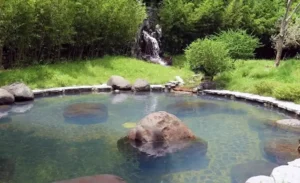 Kim Boi is a rest house 30km form Hoa Binh. The house was built near a large pool of mineral water. Visitors sitting inside the house can hear the sprouting water which maintains a constant temperature of 36ºC.
Kim Boi is a rest house 30km form Hoa Binh. The house was built near a large pool of mineral water. Visitors sitting inside the house can hear the sprouting water which maintains a constant temperature of 36ºC.
Scientific tests have shown that the mineral water at Kim Boi is suitable for drinking, bathing and for the treatment of rheumatism, intestinal diseases, stomach-aches and high-blood pressure. Kim Boi mineral water is bolted for drinking and is comparable to some well known foreign brands.
Historical and cultural relics
Binh Son Tower
 Binh Son Tower is situated near Vinh Khanh Pagoda and belongs to Binh Son village, Tam Son commune. Erected during the Ly-Tran Dynasty, the 16m tower has 11 floors, each with a curved roof. It was built from terra-cotta baked at a high temperature. The foundations are make of vo bricks (bricks made with a mallet) whereas the exterior surface of the tower is built of dark red bricks decorated with very fine lines. The results is an harmonious architectural complex.
Binh Son Tower is situated near Vinh Khanh Pagoda and belongs to Binh Son village, Tam Son commune. Erected during the Ly-Tran Dynasty, the 16m tower has 11 floors, each with a curved roof. It was built from terra-cotta baked at a high temperature. The foundations are make of vo bricks (bricks made with a mallet) whereas the exterior surface of the tower is built of dark red bricks decorated with very fine lines. The results is an harmonious architectural complex.
Through many centuries, the tower has been leaning and its foundations have collapsed in several locations. In 1972, the foundations were rebuilt in concrete, 4m higher but still faithful to the original architectural style.
Hoa Binh Power Plant
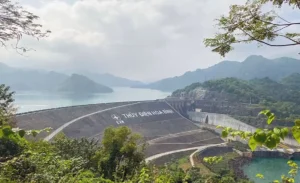 The Hoa Binh Hydroelectric Power Plant in Hoa Binh ward is the largest in Vietnam, a symbol of the province. Its construction began in November 1979, with assistance from the former Soviet Union. The electricity generating section was built inside a mountain. The plant has 8 generators, each with a capacity of 240,000 KW. The plant’s reservoir along the Da River has become an attractive tourist site.
The Hoa Binh Hydroelectric Power Plant in Hoa Binh ward is the largest in Vietnam, a symbol of the province. Its construction began in November 1979, with assistance from the former Soviet Union. The electricity generating section was built inside a mountain. The plant has 8 generators, each with a capacity of 240,000 KW. The plant’s reservoir along the Da River has become an attractive tourist site.
Currently, the entrance fee is 20,000 VND, for visitors who only visit the outside area. If you want to visit the technical area and machinery, you can buy a ticket for 50,000 VND.
Another stop when coming to the city is the statue of President Ho Chi Minh on Ong Tuong Hill. From the left, visitors can look out to see the whole city. On the right, you can see the majestic and imposing hydroelectric plant from above.
Sacred temples and pagodas
Truc Lam Tay Thien Zen Monastery
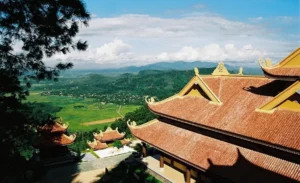 About 25 km from Tam Dao, Truc Lam Tay Thien Zen Monastery possesses a charming landscape, located on a majestic high mountainside among pine forests and clouds. Not only is it the temple with the most magnificent architecture in northern Vietnam, it is also one of the three largest Zen monasteries in the country. The majestic wild natural landscape, along with the sacred atmosphere of the place of practice, makes the Zen monastery have a peaceful and otherworldly beauty.
About 25 km from Tam Dao, Truc Lam Tay Thien Zen Monastery possesses a charming landscape, located on a majestic high mountainside among pine forests and clouds. Not only is it the temple with the most magnificent architecture in northern Vietnam, it is also one of the three largest Zen monasteries in the country. The majestic wild natural landscape, along with the sacred atmosphere of the place of practice, makes the Zen monastery have a peaceful and otherworldly beauty.
Along with Truc Lam Da Lat and Yen Tu Zen Monasteries, Truc Lam Tay Thien Zen Monastery is one of the three largest Zen monasteries in the country. Visiting the pagoda, visitors not only burn incense to pray for luck and fortune, but also enjoy the beautiful scenery of the mountains and forests here. Next to Truc Lam Tay Thien Zen Monastery is Truc Lam An Tam Zen Monastery, a place of practice for nuns.
Tich Son Pagoda
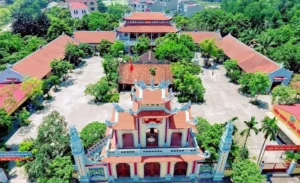 Tich Son is an ancient pagoda, a spiritual tourist destination for Vinh Phuc people and many visitors from all over the world. There are no documents clearly stating the time of construction of Tich Son Pagoda, however, through the architecture, many researchers believe that the pagoda was built at the end of the Later Le Dynasty, the beginning of the Nguyen Dynasty and has undergone many renovations.
Tich Son is an ancient pagoda, a spiritual tourist destination for Vinh Phuc people and many visitors from all over the world. There are no documents clearly stating the time of construction of Tich Son Pagoda, however, through the architecture, many researchers believe that the pagoda was built at the end of the Later Le Dynasty, the beginning of the Nguyen Dynasty and has undergone many renovations.
There are still 16 statues made of wood and bronze, arranged in the sanctum and the Patriarch’s house. In particular, among the statues in Tich Son Pagoda, the Amitabha statue has special value. This statue is made of solid bronze, 1 meter high, in a meditative posture, sitting on a lotus pedestal, also cast in one piece. In addition to the system of worship statues and wood carvings, Tich Son Pagoda also preserves a bronze bell cast in the 12th year of Minh Mang (1832) and an ancient bronze gong, both of which are precious antiques.
Lang Suong Temple
The national historical site Lang Suong Temple is located in Tu Vu commune, about 45 km from Viet Tri ward. This is the only temple that worships the entire family of Saint Tan Vien Son – one of the gods honored by the people as “The Four Immortals” in the Vietnamese folk belief of worshiping gods.
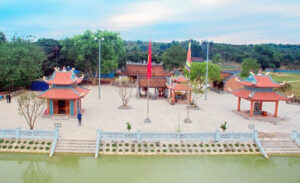 In particular, it was Tan Vien Son who advised the 18th King Hung to give up the throne to Thuc Phan to maintain solidarity and avoid unnecessary civil war. Later, he moved to Tan mountain to live with his wife, Princess Ngoc Hoa. With his great contributions, the people built a temple to worship him and burn incense all year round to show their gratitude.
In particular, it was Tan Vien Son who advised the 18th King Hung to give up the throne to Thuc Phan to maintain solidarity and avoid unnecessary civil war. Later, he moved to Tan mountain to live with his wife, Princess Ngoc Hoa. With his great contributions, the people built a temple to worship him and burn incense all year round to show their gratitude.
Not only is it an ancient temple with preserved and kept antiquities such as Ngoc Trien, Ngoc Pha, but the relics of the kneeling stone, Thien Thanh well, the belly-compressing stone, the bathing water basin, and the Hai Co Temple here have also become sacred highlights of Lang Suong Temple.
The Thien Thanh well is only 3m deep, but whether it is the wet season or the dry season, the well is still clear and full of water even though the surrounding wells are dry. That mystery and sacredness attracts the curiosity and appeal of tourists.
Traditional craft and ethnic villages
Huong Canh Pottery Village
 Huong Canh Pottery Village, in Binh Nguyen commune, is located right next to National Highway No 2. This place is not only famous for its pottery making but also a very beautiful ancient village. In the village, there are 3 large communal houses built with baked bricks and ironwood about 500 years old (worshiping the 3 sons of Ngo Quyen), the Ca Pagoda, the sacred Lo Ngoi Pagoda.
Huong Canh Pottery Village, in Binh Nguyen commune, is located right next to National Highway No 2. This place is not only famous for its pottery making but also a very beautiful ancient village. In the village, there are 3 large communal houses built with baked bricks and ironwood about 500 years old (worshiping the 3 sons of Ngo Quyen), the Ca Pagoda, the sacred Lo Ngoi Pagoda.
Coming to Huong Canh pottery village, you can rent a bicycle to ride around the village or walk to witness the pottery making process and see the jars, pots, vases, terracotta pots… everywhere here.
In addition to the traditional products, some tiles, “antique”jars and other beautiful high quality products are produced in Huong Canh. Unlike the enamelled pottery from Bat Trang, Huong Canh’s products are unbleached.
Muong villages
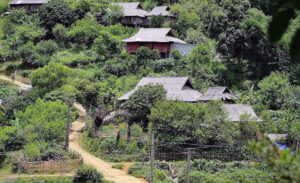 The Muong ethnic group in Hoa Binh lives in the valleys of the wet rice fields. At Thung May, 1200m above sea level, visitors can enjoy a clear view of the beautiful scenery of the Muong land and discover the unique culture and life of the people.
The Muong ethnic group in Hoa Binh lives in the valleys of the wet rice fields. At Thung May, 1200m above sea level, visitors can enjoy a clear view of the beautiful scenery of the Muong land and discover the unique culture and life of the people.
They also possess fascinating rituals for weddings, funerals or great mountain worship ceremonies like de dat and de nuoc (giving birth to the land and the water).
Drums and gongs still play an important role in Muong misic. During the spring festival, when people are going down to the rice fields or during houses warming celebrations, the misical sound of the Muong’s set of 12 gongs can be heard and enjoyed. The babbling of stream, the rustling of forest trees and the beating of gongs are unforgettable sound of the Muong land. In the Muong mountain villages, visitos will receive a friendly welcome to their uinique culture.
Lac Village in Mai Chau valley
Mai Chau valley is approximately 150km from Hanoi, 70km from the town of Hoa Binh. Lac village is located in Chieng Mai Commune, 1km from the town center of Mai Chai District. The beautiful district of Mai Chai lies in a green valley of paddy fields dotted with rows of stilt houses, belonging to the Tha community.
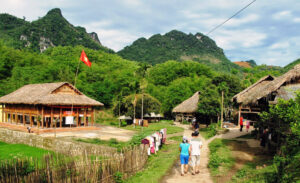 The stilt houses are built from hard wood and stand about 2m above the ground. The roofs are often made of palm leaves. The windows are relatively large to allow frest air to circulate and are decorated with baskets of orchids and bird cages hanging on the outside.
The stilt houses are built from hard wood and stand about 2m above the ground. The roofs are often made of palm leaves. The windows are relatively large to allow frest air to circulate and are decorated with baskets of orchids and bird cages hanging on the outside.
A handloom with a young women weaving brocade can often be seen through the windows. A young man wishing to ask for her hand in marriage examines the blankets and mattresses decorated with colourful designs to evaluate the diligence and domesticity of his furture bride. Similarly, a young girl judges the working ability of her future husband by looking at the number of fish scales and tails trophies stuck to the wooden pillars.
Visitors are encouraged to take of their shoes and even to clean their feet with water before entering the houses. Hosts spread mats on the floor and invite their gusts to sit down and drink home-brewed rou can alcohol. Meanwhile, the wives cook glutinous rice. There is often a fish tank close to th house. The Host allows his guests to choose the fish they want for their soup.
An overnight stay at one of the stilt houese in Mai Chai will be entivened by folk dances and songs thhat are accompanies by gong music. It costs about 5USD to stay overnight and 1USD for a meal.
Bich Chu traditional carpentry village
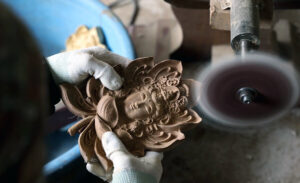 Bich Chu carpentry village, in Vinh Phu commune is famous far and wide for its woodworking techniques. The artisans here not only make ordinary wooden furniture such as cabinets, beds, tables and chairs, but also create wooden products with high artistic value such as wooden statues displayed in shrines, temples, gilded lacquered panels… bearing the traditional cultural features.
Bich Chu carpentry village, in Vinh Phu commune is famous far and wide for its woodworking techniques. The artisans here not only make ordinary wooden furniture such as cabinets, beds, tables and chairs, but also create wooden products with high artistic value such as wooden statues displayed in shrines, temples, gilded lacquered panels… bearing the traditional cultural features.
After more than 400 years, Bich Chu carpentry village today continues to be preserved, passed down and promoted by generations. The products of the village have designs and quality that meet the tastes of customers and the diverse needs of the market.
In recent years, Bich Chu craft village products have always been highly appreciated by consumers for both quality and design. Currently, the village’s products are present in all provinces in the North and South such as Hanoi, Thai Nguyen, Hai Phong, Tuyen Quang,…
Vinh Son Snake Farming Village
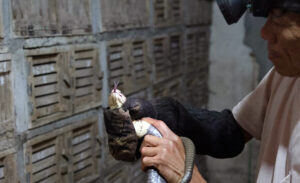 Snake farming in Vinh Phuc has existed for a long time, closely linked to the tradition of hunting snakes in the wild of local people. The most famous is Vinh Son snake farming village, Tho Tang commune, with a history of more than 100 years.
Snake farming in Vinh Phuc has existed for a long time, closely linked to the tradition of hunting snakes in the wild of local people. The most famous is Vinh Son snake farming village, Tho Tang commune, with a history of more than 100 years.
The main products of Vinh Son snake farming village are commercial snakes and breeding snakes. In addition, traders also buy snakes to process snake wine, snake glue, molted snake carcasses are purchased for medicinal purposes, snake venom is used in pharmaceuticals, snake skin is used to make decorative belts, leather wallets, snake gall is used to treat asthma, digestive diseases, etc.
Currently, visitors to Vinh Son snake farming village will enjoy many services such as: visiting the breeding area, directly observing animals that are gradually becoming rare in the natural environment, feeling the difficulties of snake farming; enjoying delicious and unique dishes made from snakes and leaving with the joy of owning meat products, glue, wine, etc. from snakes.
Hung Lo Ancient Village
Located on the poetic Lo River in the middle of Viet Tri ward, Hung Lo Ancient Village is an attractive destination for domestic and foreign tourists. The ancient village is about 10 km from Hung Temple, convenient for tourists to visit after their pilgrimage on the occasion of the Hung King’s death anniversary.
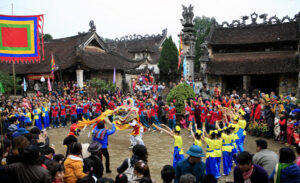 This place is attractive for its ancient features, unique architecture of the communal house over 300 years old, ancient houses, traditional craft villages, preserving many traditional cultural features associated with the worship of Hung Kings and ancient customs.
This place is attractive for its ancient features, unique architecture of the communal house over 300 years old, ancient houses, traditional craft villages, preserving many traditional cultural features associated with the worship of Hung Kings and ancient customs.
After many historical ups and downs, Hung Lo Ancient Village still preserves almost intact the architecture of the ancient communal house built in 1697 under King Le Hy Tong. Hung Lo Communal House has been recognized as a national historical relic since 1990. In addition to its architectural value, the Communal House is like a miniature museum with precious antiques made of paper, wood, bronze, stone, porcelain, royal decrees, parallel sentences praising the merits of the Hung Kings, five gilded palanquins, a system of worship objects…
Specialties of Phu Tho
The current Phu Tho province was merged from Phu Tho, Vinh Phuc and Hoa Binh province. Therefore, the cuisine is extremely diverse and rich.
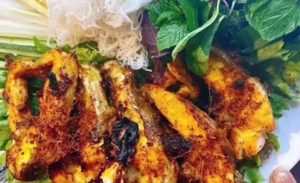 Viet Tri area is also known as the city of the intersection of Lo, Hong, and Da rivers, so the river cuisine here is diverse and delicious. Among them, the Da River catfish with firm, sweet meat and few bones cannot be missed. According to legend, this fish was used to pay tribute to the king. In Viet Tri, catfish is grilled with galangal, salted, cooked with sour bamboo shoots, mixed with shallots… Visitors can choose the fish swimming in the tank and request processing.
Viet Tri area is also known as the city of the intersection of Lo, Hong, and Da rivers, so the river cuisine here is diverse and delicious. Among them, the Da River catfish with firm, sweet meat and few bones cannot be missed. According to legend, this fish was used to pay tribute to the king. In Viet Tri, catfish is grilled with galangal, salted, cooked with sour bamboo shoots, mixed with shallots… Visitors can choose the fish swimming in the tank and request processing.
Suggested addresses to eat catfish are the Da River Catfish restaurant in Happyland area, Gia Cam ward; Hac Tri fish restaurant on Lac Long Quan street; Long Gia Quan on Hoa Vuong street. In addition to catfish, the restaurants also serve a variety of dishes such as salmon, catfish, hill chicken, local pork…
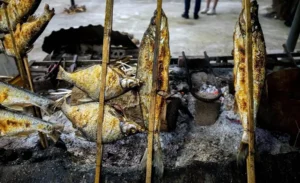 Hoa Binh Lake offers many attractive specialties, including fish such as catfish, carp, sesame, grass carp…Fish grilled on a charcoal stove with bamboo sticks is a specialty that is easy to find on the way to Thac Bo cave. Batches of fish are cleaned of scales and intestines, marinated with salt and pepper, then grilled.
Hoa Binh Lake offers many attractive specialties, including fish such as catfish, carp, sesame, grass carp…Fish grilled on a charcoal stove with bamboo sticks is a specialty that is easy to find on the way to Thac Bo cave. Batches of fish are cleaned of scales and intestines, marinated with salt and pepper, then grilled.
The fish are then placed on green banana leaves, served with young dracontomelon leaves, perilla leaves, and lolot leaves. The fish meat is firm, sweet, and has a fragrant charcoal-grilled smell and a faint scent of bananas and bamboo.
 Chicken cooked with sour bamboo shoots is also a specialty of Phu Tho. Fresh bamboo shoots are picked from the forest, chopped, washed, and salt is added to ferment naturally. The bamboo shoots are light yellow, fragrant, and have no scum. The chicken often chosen to cook bamboo shoot soup is hill chicken, which is chewy and fragrant.
Chicken cooked with sour bamboo shoots is also a specialty of Phu Tho. Fresh bamboo shoots are picked from the forest, chopped, washed, and salt is added to ferment naturally. The bamboo shoots are light yellow, fragrant, and have no scum. The chicken often chosen to cook bamboo shoot soup is hill chicken, which is chewy and fragrant.
After cleaning, it is chopped, stir-fried with onion and fat until firm. Then the chicken is simmered with sour bamboo shoots and local seeds, which has a pungent, fragrant taste.
 Buffalo meat cooked with lom leaves, a specialty of the Muong people in Hoa Binh area, is also very popular. The buffalo meat is grilled, scraped clean, then spread until soft. When the meat is relatively cooked, cut it into smaller pieces, put it in a clay pot to stew thoroughly. The sour lom leaves are crushed and broken rice is put into the pot to stew with the buffalo meat. Keep the fire going until the broken rice expands and thickens. The buffalo meat is well-cooked, soaked in the sour taste of lom leaves and the fragrant aroma of rice, making it easy to eat.
Buffalo meat cooked with lom leaves, a specialty of the Muong people in Hoa Binh area, is also very popular. The buffalo meat is grilled, scraped clean, then spread until soft. When the meat is relatively cooked, cut it into smaller pieces, put it in a clay pot to stew thoroughly. The sour lom leaves are crushed and broken rice is put into the pot to stew with the buffalo meat. Keep the fire going until the broken rice expands and thickens. The buffalo meat is well-cooked, soaked in the sour taste of lom leaves and the fragrant aroma of rice, making it easy to eat.
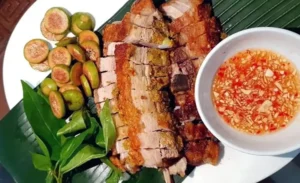 Sour pickled pork gives visitors the feeling of enjoying both the plants and the taste of the forest due to its unique way of making. The sour pickled pork dish is made very elaborately and combined with many types of forest leaves. All are readily available products that are easy to find, and each type of leaf is considered a valuable medicine that is beneficial to the body, such as cinnamon leaves, jackfruit leaves, betel leaves, etc. The first impression when guests come to the house is that the Muong people bring out a tray of sour pickled pork with a basket of leaves. When eating, you have to use your hands to roll the leaves with the meat, chew slowly, it is very rich, fragrant, sweet, and tastes very strange.
Sour pickled pork gives visitors the feeling of enjoying both the plants and the taste of the forest due to its unique way of making. The sour pickled pork dish is made very elaborately and combined with many types of forest leaves. All are readily available products that are easy to find, and each type of leaf is considered a valuable medicine that is beneficial to the body, such as cinnamon leaves, jackfruit leaves, betel leaves, etc. The first impression when guests come to the house is that the Muong people bring out a tray of sour pickled pork with a basket of leaves. When eating, you have to use your hands to roll the leaves with the meat, chew slowly, it is very rich, fragrant, sweet, and tastes very strange.
Hoa Binh wild boar meat has little fat and a lot of lean meat, crispy and sweet. Pork can be boiled, roasted, or grilled. Visitors can eat it with Hoa Binh’s famous bamboo rice, which is fragrant and sticky because it is made from upland sticky rice. Visitors can find these specialties at Bep Muong or Hoa Qua Son restaurants in Kim Boi. In Mai Chau, there is Hop Thuy restaurant, sub-area 2 or the restaurant in Mai Chau Ecolodge resort.
Source: collected by An
Follow us for the best deal with Vietnam package tours and visa services!





